New forecast data is now released for Winter 2022/2023. It shows a growing influence of the third-year La Nina phase. It is currently cooling down and expected to continue into early Winter. Modifying the jet stream pattern over North America and the Pacific Ocean will also extend its reach to the rest of the world.
To understand the Winter season, we must realize that there are many “drivers” of weather. Global weather is a very complex system, with many large-scale and small-scale climate influencers.
But how can the oceans have such an impact on winter weather? We will first examine what this La Nina is, how it works, and how it is predicted to change as we get closer to the Winter season of 2022/2023.
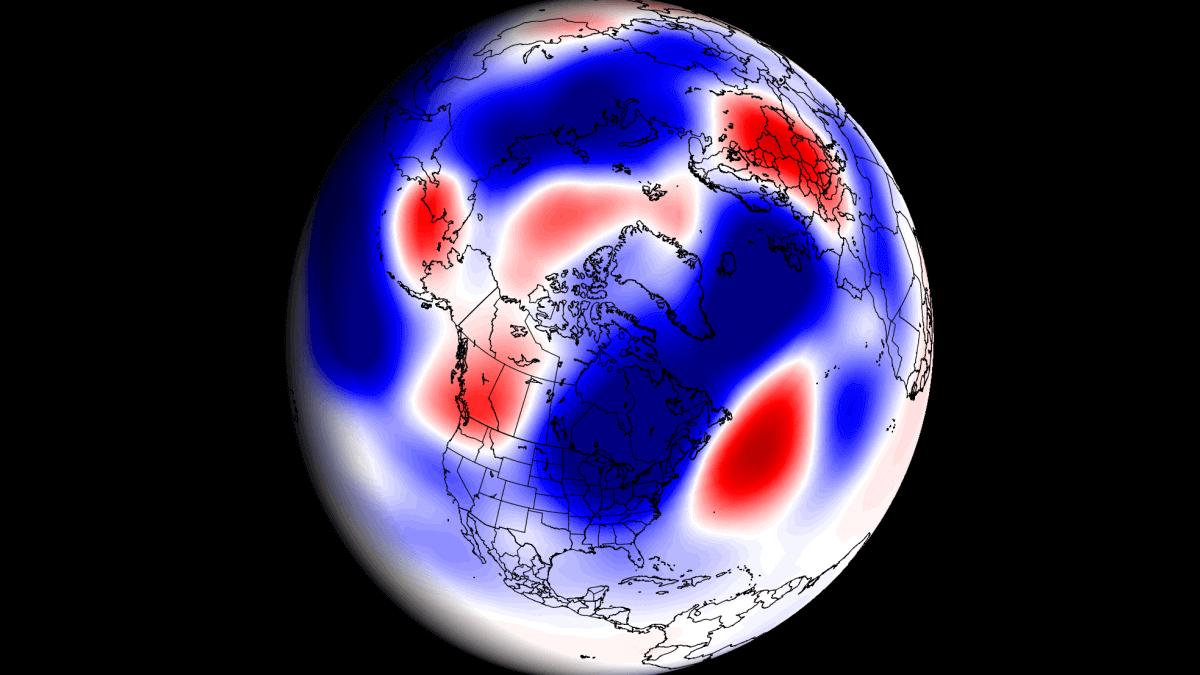
WEATHER FROM THE OCEAN
Oceans cover over 70% of the planet’s surface and play a significant role in the Earth’s climate system. In the image below, you can see the complex air-sea interactions. This is a two-way system with influences going both ways on smaller and larger scales.
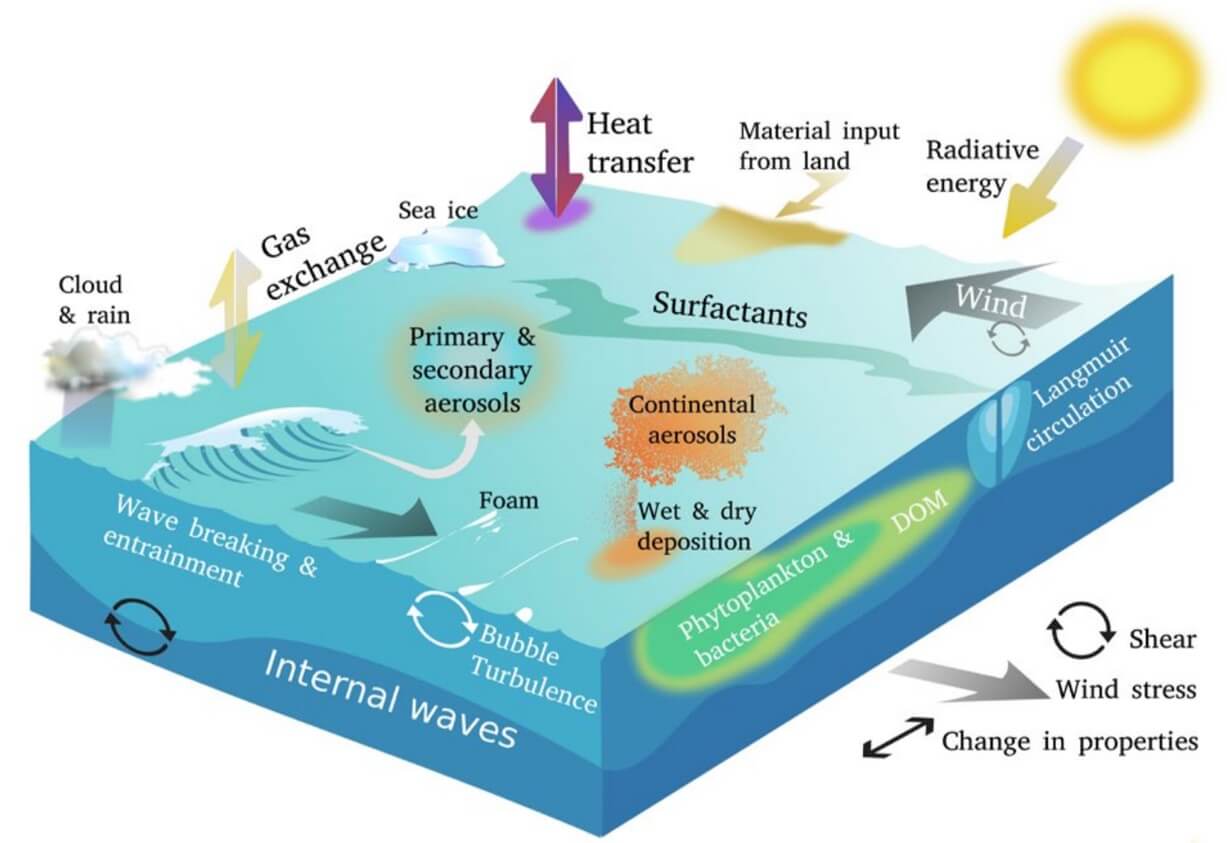
The key here is the word “two-way.” For example, we sometimes look at ocean anomalies and how they will influence our long-term weather, while the weather also influences ocean anomalies.
So it is very important to note that while the oceans can play their climate role directly, they are also changing due to the weather patterns.
Looking at the latest ocean anomalies, we have marked a few regions we are currently watching for Winter 2022/2023 development. Each has its role and significance in different areas and time scales.
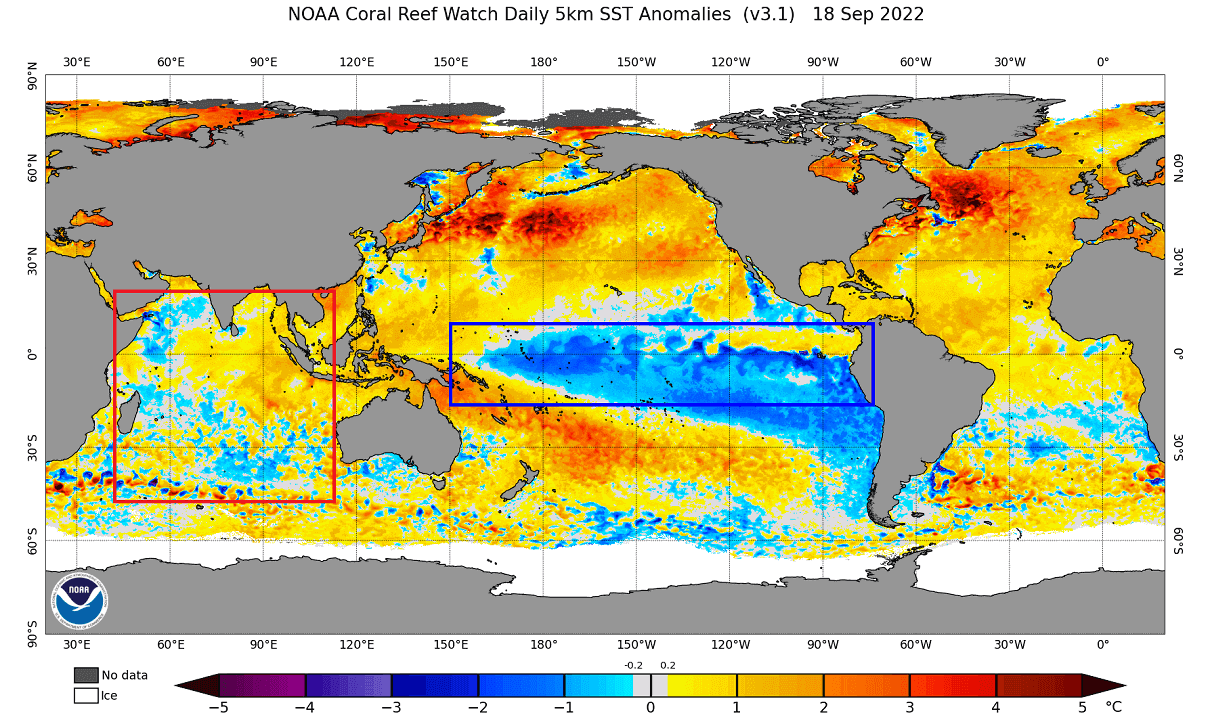
Marked in the center is the El Nino Southern Oscillation or ENSO. This is one of the most well-known ocean oscillations, with an especially strong influence during Winter.
You can see the Dual Mode Index (DMI) on the left. It oscillates based on the temperature difference between the east and west Indian ocean. It will also play its role in the Winter.
ENSO WEATHER PATTERNS
ENSO is short for “El Niño Southern Oscillation.” This region of the equatorial Pacific Ocean changes between warm and cold phases. Typically there is a phase change around every 1-3 years.
The cold phase is called La Nina, and the warm phase is called El Nino. We are currently in a La Nina phase, entering its 3rd year, which is a rather rare occurrence.
ENSO significantly changes tropical rainfall, pressure patterns, and the complex exchange between the ocean and the atmosphere. With each new developing phase, large-scale pressure changes are observed in the tropics.
The image below from NOAA Climate shows the typical circulation during a cold ENSO phase. Air descends in the eastern Pacific, promoting stable and dry weather. At the same time, the air is rising in the western Pacific, with a lot of rainfall and lower pressure.

This way, ENSO significantly impacts the tropical rainfall and pressure patterns and thus impacts the ocean-atmosphere feedback system. Through this ocean-atmosphere system, the ENSO influence spreads globally.
Below we have a close-up view of the tropical Pacific Ocean surface analysis. We can see the cold anomalies in the marked ENSO regions. That is the currently active La Nina entering its third-year phase.
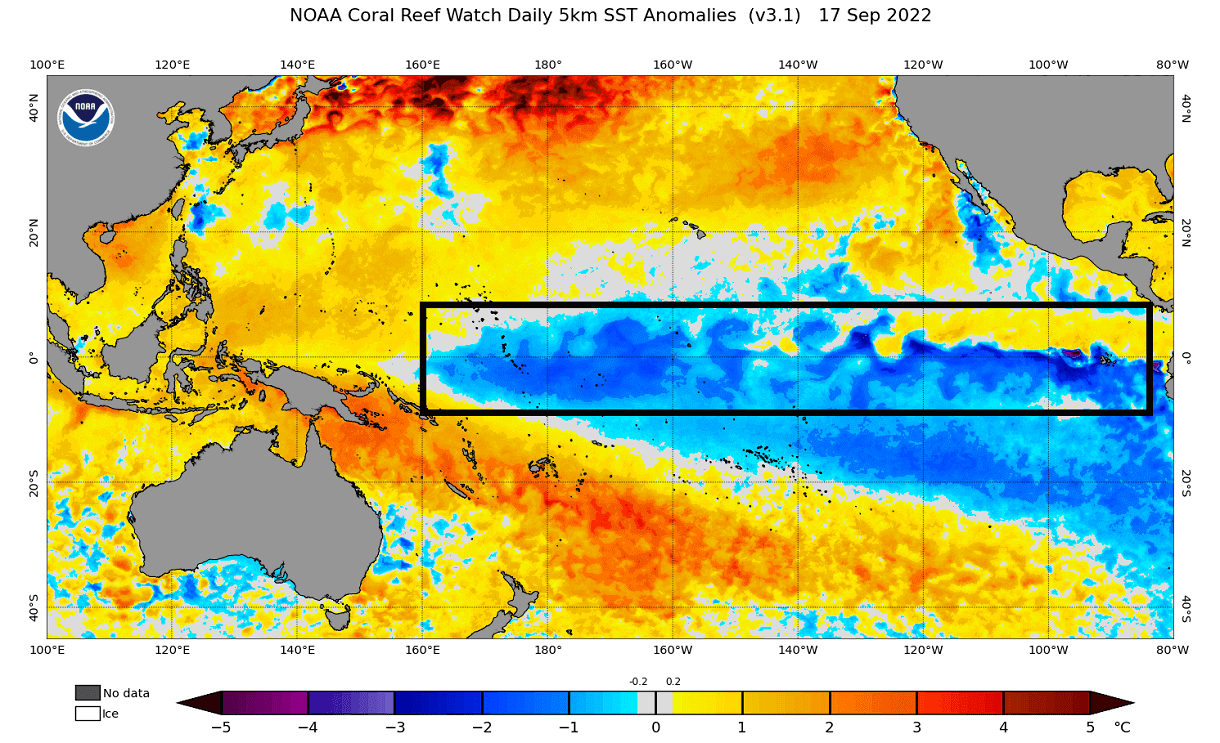
La Nina forms during strong easterly trade winds, which can tell us much about the general state of global circulation. This way, we can use these anomalies as an “indicator” to know the current state of the global climate system.
Below, you can see the last years of ocean anomalies in the ENSO region. You can see the first La Nina event in 2020 and a second-year La Nina in late 2021, lasting through the Winter. A third-year event is forecast to develop over the Fall and Winter 2022/2023.
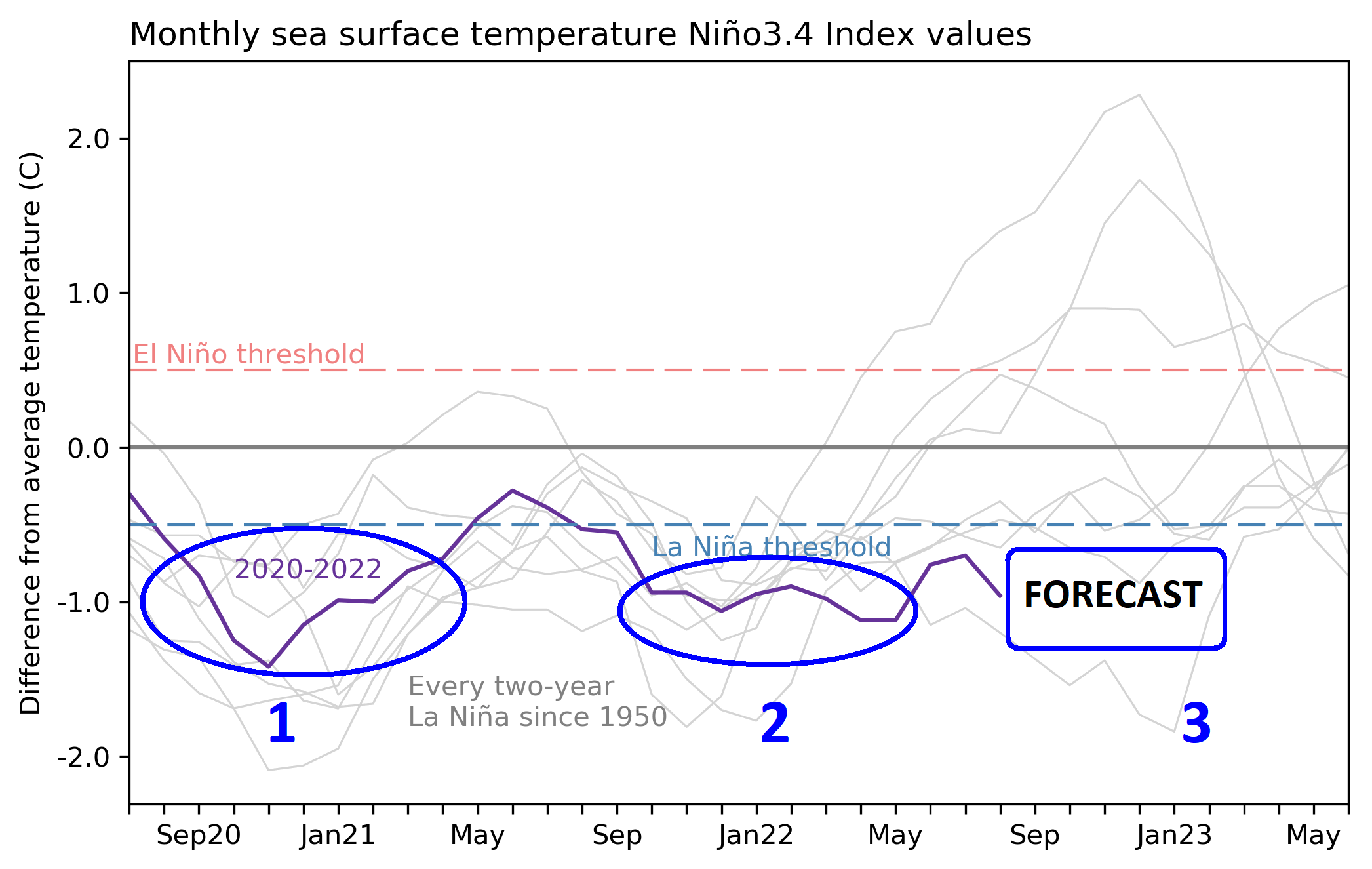
To better understand the ENSO development, we produced a video showing the La Nina anomalies from late Spring until the present. The video below shows the cold ocean anomalies in the equatorial Pacific. Notice the “waveforms” across the region as trade winds push the surface waters west.
ENSEMBLE FORECAST
Below we have an analysis/forecast graphic by ECMWF, which shows the forecast of the central ENSO region. The La Nina conditions (below -0.5) will prevail over the Fall and Winter. But a weakening of the La Nina is expected for early next year, with a warm phase possible later in the year.
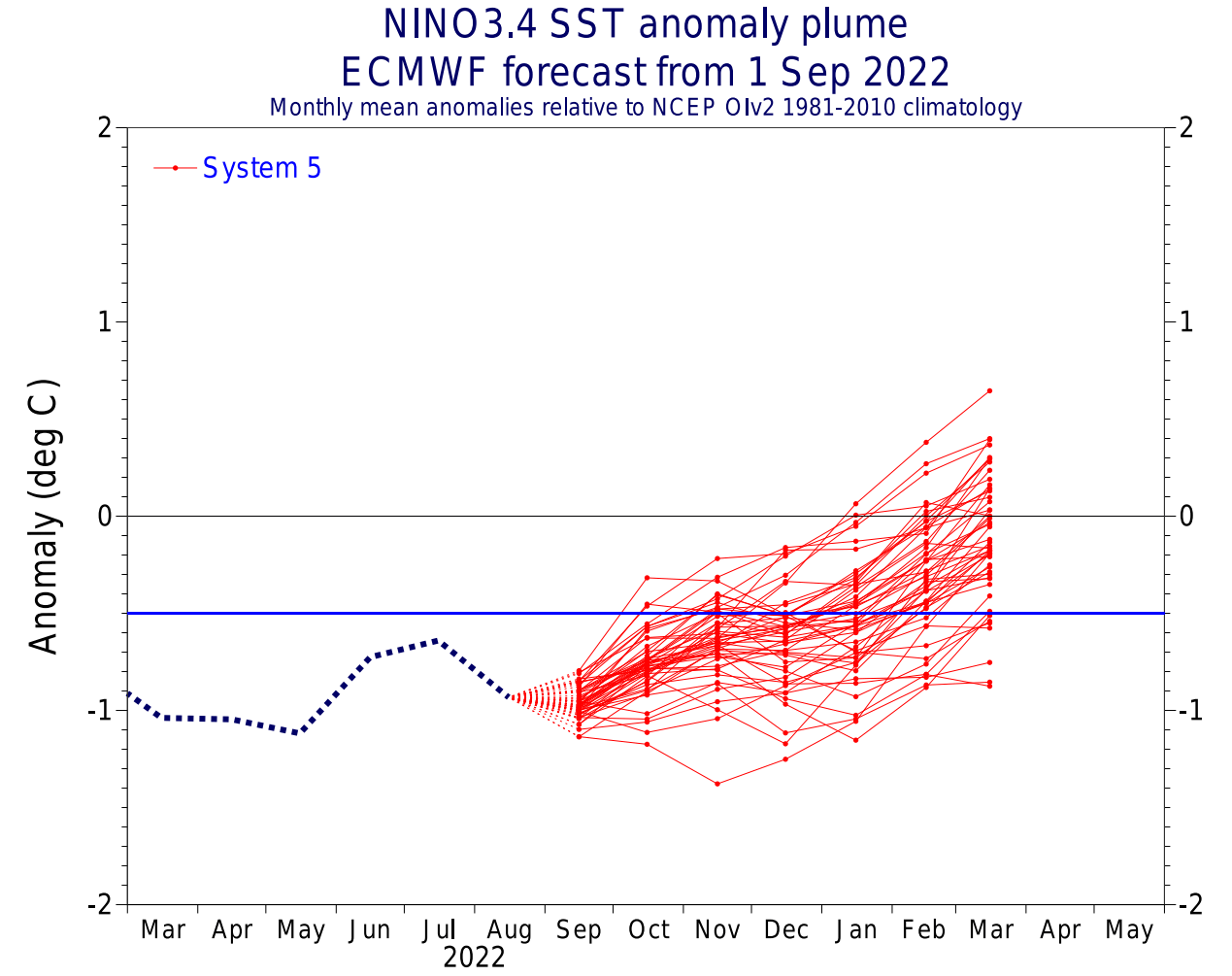
Looking at the Official NOAA CPC probability forecast, we can see a high agreement for the cold phase. It is expected to remain stable going into Winter. We expect a breakdown of the cold phase as we go into next Spring.

The combined model ocean forecast shows the cold anomalies in the Pacific regions over late Fall and early Winter. A stable La Nina is forecast on all long-range systems, giving high confidence also for its weather influence.

The ensemble forecast from the CFS model, which we will also use in the atmospheric winter forecast, shows a healthy cold phase developing. It goes strong into Winter but weakens over Spring.
WINTER AND THE POLAR JET STREAM
Typically, the first influence of these ocean anomalies can be seen in the changing jet stream. The jet stream is a large and powerful stream of air (wind) at around 8-11km (5-7mi) altitude. It interacts with pressure systems and affects their path and evolution.
The jet stream is an important piece of this story. It is one of the main ways La Nina can change the weather patterns more directly, especially over North America.
Historically, a strong blocking high-pressure system in the North Pacific is the most typical effect of a cold ENSO phase. That usually redirects the polar jet stream down over the northern United States.
The image below shows the average pattern during the last La Nina winters. We can see a strong high-pressure system in the North Pacific and a low-pressure area over Canada and southwestern Europe.

The circulation of the strong high-pressure system promotes the development of a low-pressure region over Alaska and western Canada. It curves the jet stream downwards in between the two pressure systems.
Looking at the temperature analysis for the same winters, we can see the cold anomaly under the jet stream in western Canada and the northern United States. There are also some cold anomalies over Europe, but they can’t be attributed directly to La Nina.

You can see that jet stream re-position in the image below. The image shows the average position of the jet stream during La Nina winters and the resulting weather patterns over the United States and Canada.
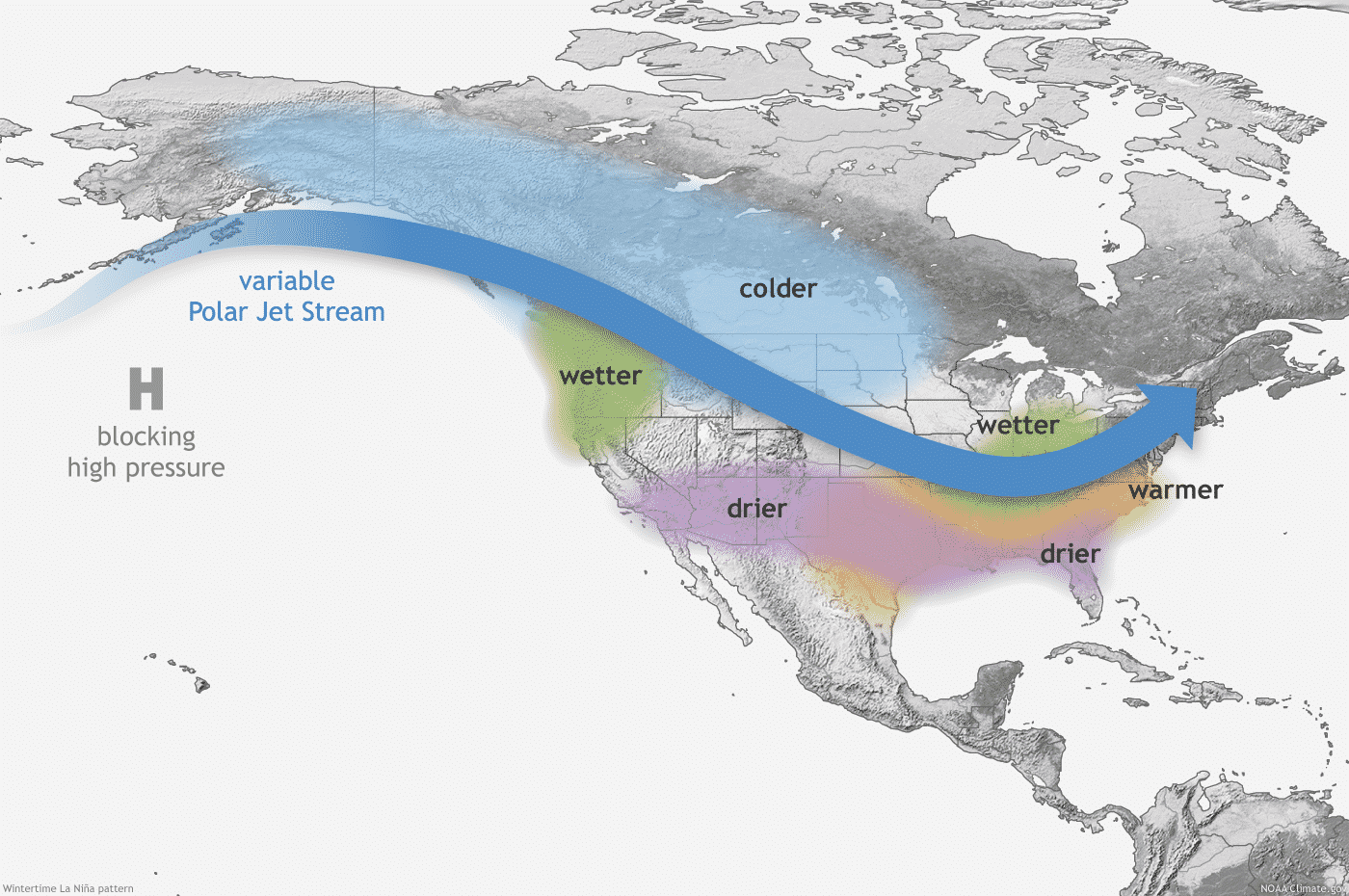
The shifting jet stream brings colder temperatures and storms from the polar regions down into northern and the northwestern United States and warmer and drier weather to the southern parts.
In the northern part of the country, colder and wetter events are more frequent, as the jet stream directs the storm systems that way. But that can somewhat lockout the southern United States, creating warmer and more stable weather with less frequent storms and cold fronts.
As the colder air is more easily accessible to the northern United States, it also increases the snowfall potential. Especially areas like Alaska, Canada, and the northern/northwestern United States benefit from more snowfall in a cold ENSO phase. The graphic is provided by NOAA-Climate.
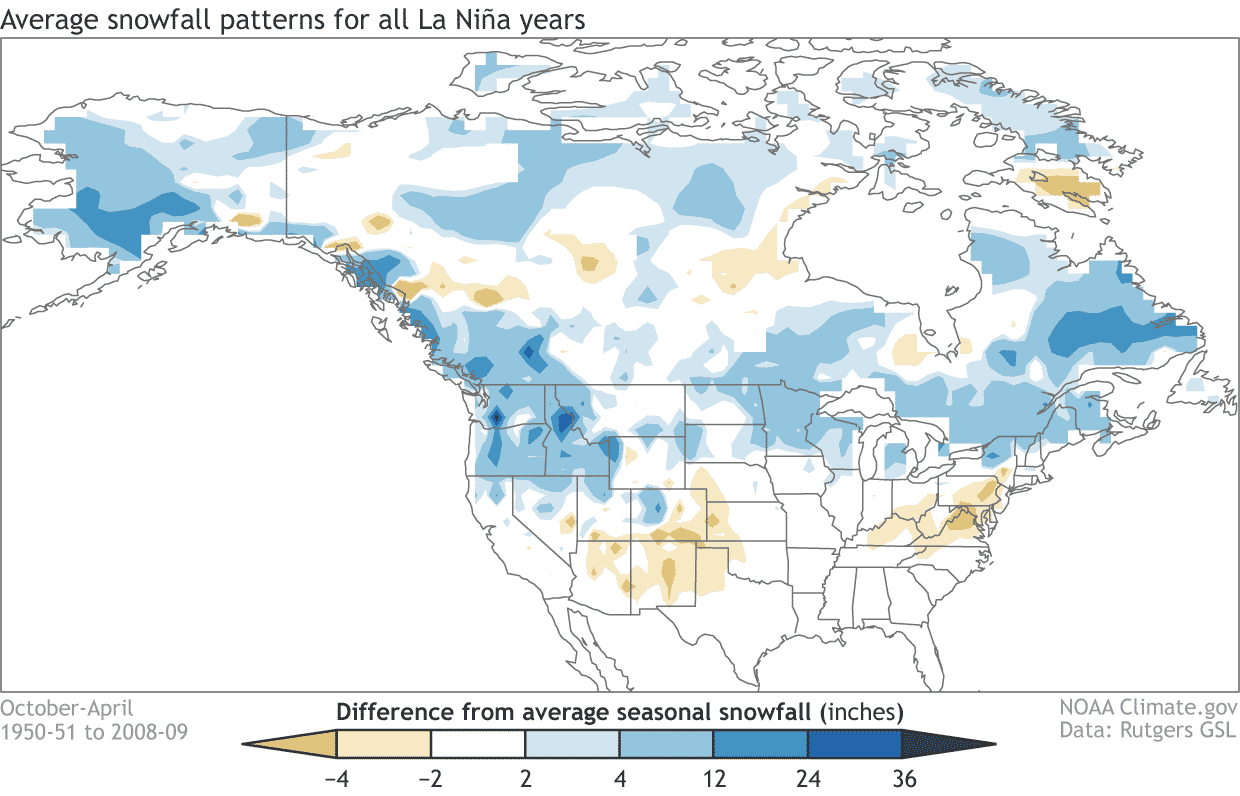
WINTER SEASON 2022/2023 – SEPTEMBER FORECAST UPDATE
You now know what will influence this upcoming Winter and how it will change our jet stream and weather. We will now also look at the actual model forecast, freshly updated in September, and their hints are for Winter 2022/2023.
In this update, we focused on three seasonal models. The ECMWF from Europe, the CFSv2 from the United States, and a special blend of North American models called NMME. Graphics are from the Copernicus Climate project and CPC/NCEP.
All these forecasts are an average picture over the course of 3 meteorological winter months (December-January-February) and show the general prevailing weather patterns.
Even if the models were 100% accurate, it does not mean that such weather conditions would last for three months straight. It only suggests how the weather patterns might look most of the time.
ECMWF WINTER SEASON FORECAST UPDATE
The ECMWF model is often considered one of the most reliable forecasting systems. But no long-range/seasonal forecast can be called “reliable”, as we are only looking at trends and how the weather patterns might evolve on a large scale over a longer period.
The updated winter pressure pattern forecast from ECMWF below further consolidates the La Nina high-pressure system in the North Pacific, extending to the western United States. In addition, a low-pressure system is indicated over Canada.

We also see the North Atlantic in a weak westerly negative North Atlantic Oscillation (NAO) mode, which is a change. Also, a low-pressure area over western Europe and the Azores, opening several different pattern variations throughout Winter.
The monthly NAO forecast from ECMWF below hints at negative trends in early Winter. That would increase the chances of cold events in the eastern United States and parts of Europe. A negative NAO means higher pressure over Greenland and Iceland, disrupting the normal westerly zonal jet stream pattern.
The global airmass temperature forecast shows an interesting pattern. Most of Canada and parts of the northern United States are seen with colder to average temperatures. Warmer anomalies are forecast over the western United States but reducing to the eastern United States.

Europe shows average temperatures over the west, with the influence of the nearby low-pressure area. Warmer anomalies are forecast over parts of central Europe, rising towards the northeast.
Looking at the surface temperature probability forecast over Europe, we see an interesting pattern. Most of the continent is in the average temperature range, with a slight probability of higher than average temperatures in central parts.
Going to the precipitation forecast, we can see Europe having a mostly average precipitation signal, with some drier areas to the northeast. More precipitation is forecast over the Mediterranean.
Over Noth America, the updated ECMWF forecast shows average to colder surface temperatures over most of western Canada. Warmer than normal temperatures are forecast over the southern United States, with a weaker anomaly going toward the northern United States.

A negative NAO usually means a more northerly flow over the Midwest and the eastern United States. We have seen this development in the past in La Nina winters.
In this forecast, we do see a hint of normal to colder anomalies in the northern United States but is not yet clear how much of it is due to the negative NAO signal. That will be more clear in future updates.
The precipitation anomaly forecast for North America shows a more typical La Nina-type pattern over Canada and the United States. More precipitation is forecast over Canada and the northwestern and northeastern United States. Drier conditions remain over the southwestern United States, as usually seen in a La Nina pattern.

ECMWF FORECAST VERIFICATION
Looking back at last year, we can see that the forecast from the September update showed a similar pattern. Note that the image below is for the last Winter, so we are just comparing it to the actual data to see how accurate it was.
And looking at the actual analysis below, we can see that the ECMWF forecast last year, released in September, was good. It did not show strong negative anomalies, but it did show a neutral area over the northern United States, especially over the Midwest, the Great Lakes, and the northeast.
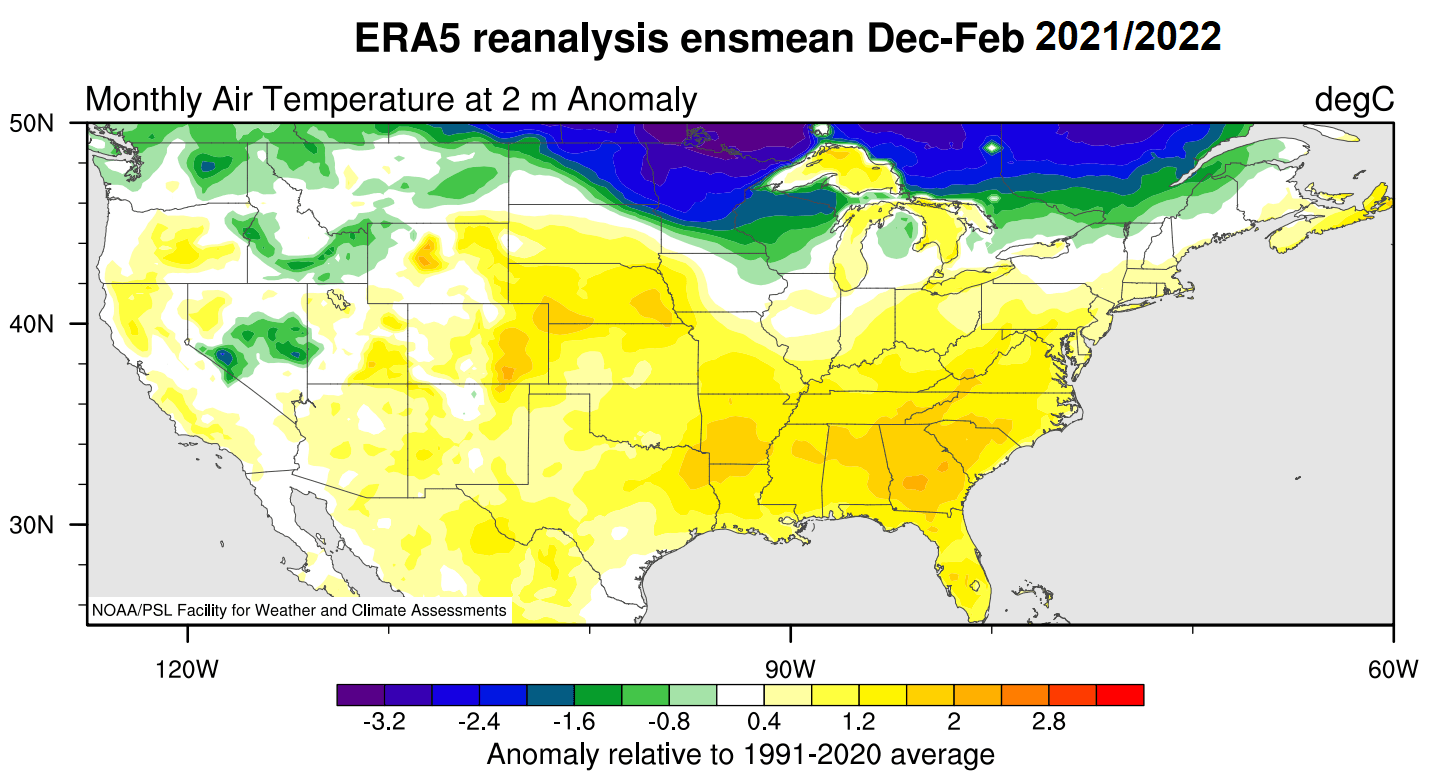
This shows some confidence in the EMCWF winter forecast, released in September, which is what we are using in this updated article. When a large-scale feature like a La Nina is active, that makes the forecast a bit more accurate, as the model has an excellent signal to rely on for the weather development.
ECMWF WINTER 2022/2023 SNOWFALL FORECAST UPDATE
As always, we produced a special snowfall forecast from the ECMWF data provided by the Copernicus-EU project. Unfortunately, over Europe, we see primarily below-average snowfall, which is surprising given the lack of strong warm anomalies and normal precipitation.

The next image below shows the raw mean snow depth for February, which is the last winter month. You can see that despite negative anomalies across most of Europe, there is still some snow cover over the continent. So even if the forecast calls for less snow, that does not mean there will be no snow.

Over North America, we see a similar forecast, with most of the country having below-average snow accumulation, except for the far northwest. It is also perhaps surprising, especially for the Midwest and the far northeast, which can get more snow in a La Nina winter.

And also, for the United States and Canada, the mean snow depth forecast for February shows the snow cover expansion. It’s reaching down into the parts of the southern Plains and in a similar line towards the east. So while showing less snowfall than normal, there still is snowfall to be expected.
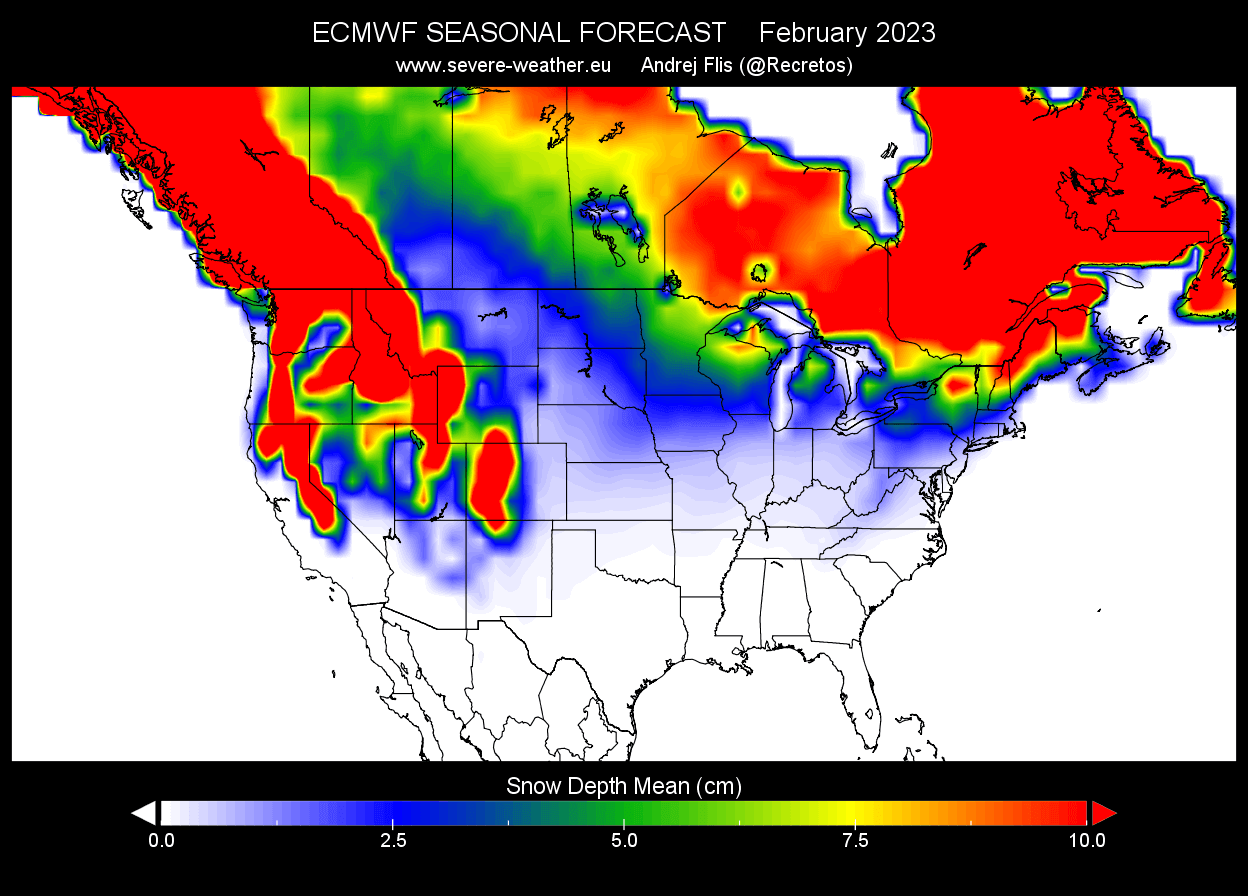
We will release a special forecast article dedicated to snowfall predictions. There, we will take a more in-depth look at snowfall potential, including more models and a month-by-month breakdown.
CFSv2 WINTER SEASON FORECAST
CFSv2 is the long-range/seasonal forecasting system from the United States NOAA/CPC. We tend to use it in contrast to the ECMWF, as it is the most widely used seasonal forecasting system in the United States.
Looking at the latest data, the CFS is close to the ECMWF with the strong La Nina high-pressure zone in the North Pacific and a low-pressure response over Canada. However, the Atlantic/Greenland pattern is almost the opposite and shows more factors are at play than just the La Nina.

Airmass temperatures are most interesting over North America, with a strong contrast of cold air anomalies over Canada and warmer air in the southern and western United States. The jet stream is usually found between the two air masses. Europe is seen as mostly warmer than normal, except for a narrow area from southwestern to northeastern regions.

The North American surface forecast shows a really strong dipole pattern. Much colder than normal temperatures over most of western and central Canada, expanding into the northern and also northeastern United States. Warmer than normal Winter is forecast over the southern and western parts of the United States.
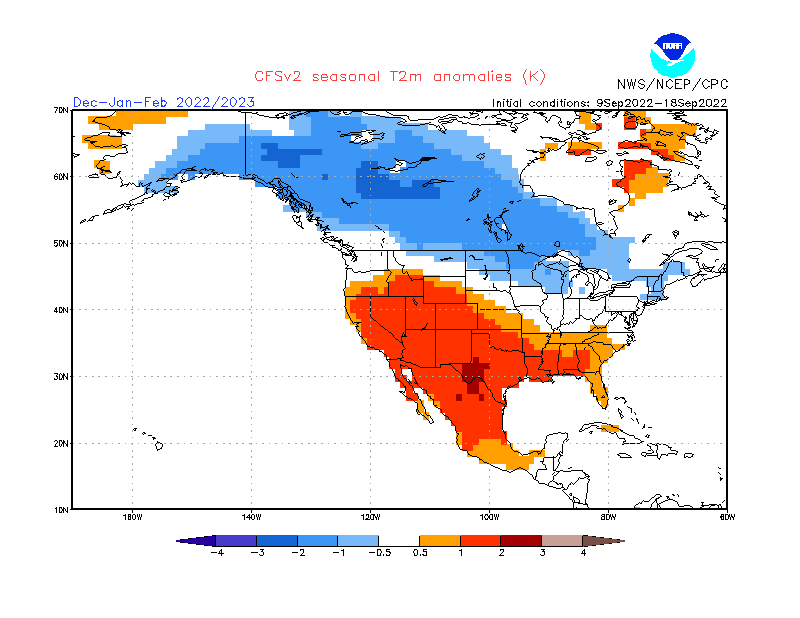
The precipitation anomaly forecast for North America shows the main weather dynamics (with increased precipitation) over the northwestern and eastern parts of the United States. Drier than normal conditions are forecast for the south, with the updated forecast showing much less precipitation over the far southeast.
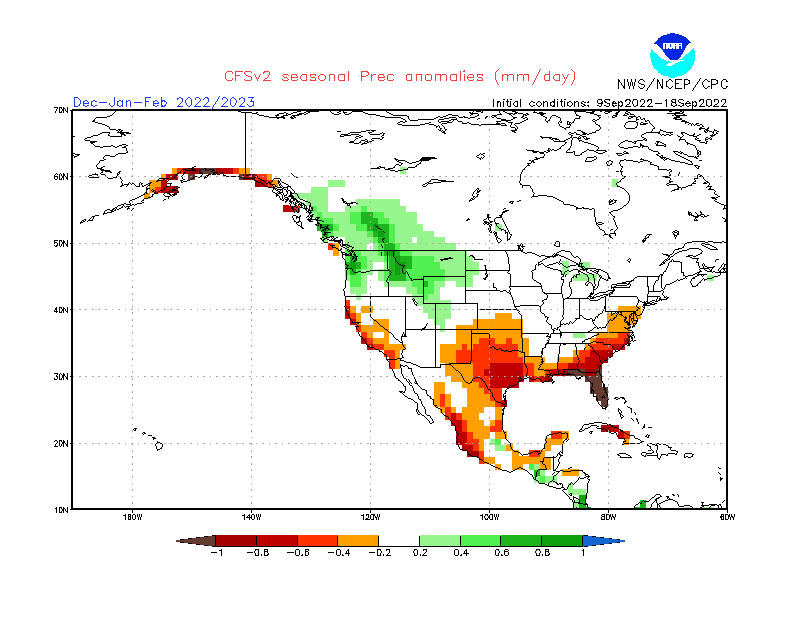
We must remember that the strongest weather dynamics unfold between the cold and warm anomalies, including snowfall. CFS has no snow forecast graphic, but this temperature and precipitation pattern would suggest more snowfall over the northwestern United States, upper Midwest, and parts of the eastern United States.
NMME WINTER 2022/2023 WEATHER FORECAST
NMME stands for North American Multi-Model Ensemble. It is a special forecast combined from several different North American long-range models. It is useful as it contains different calculations and weather solutions, providing an average forecast from different views.
The ocean temperature forecast shows the active La Nina phase over most of Winter, in agreement with other global forecasting solutions. From this, we can expect similar results also in the atmospheric forecast.

Looking at the pressure anomaly forecast, you can see a strong high-pressure system in the North Pacific, resulting from the active La Nina. A low-pressure system is over Canada, pressing the jet stream down over the northern United States.

The temperature forecast for North America shows this jet stream pattern. You can see colder temperatures over the northern United States and most of Canada. Warmer temperatures are forecast south of the jet stream in most central and southern United States.

You can see a similar pattern in the precipitation forecast below, where more precipitation is forecast over the northern half of the United States and Canada. Drier Winter is expected over much of the southern United States.
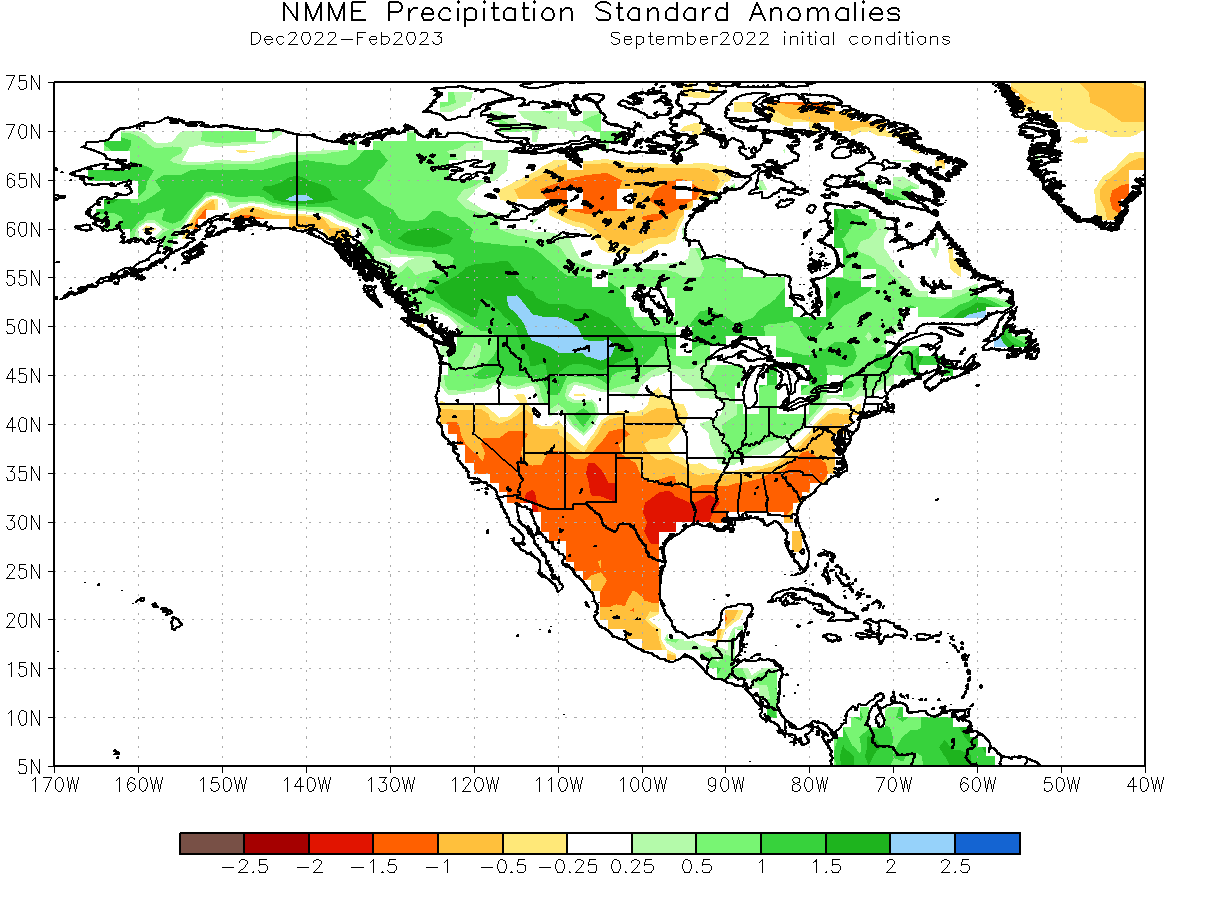
Overall this shows a very textbook La Nina winter to unfold, having a “double character” over the United States, from colder to the north to warmer over the south.
WINTER 2022/2023 UPDATE FORECAST SUMMARY
Reading images and descriptions can be somewhat confusing. So to simplify everything, here is what the September update forecast shows for the Winter season 2022/2023:
Europe is expected to have warmer than average temperatures over most of the northern and east-central parts of the continent. On the other hand, more average temperatures are expected over the west-central parts.
This suggests that there can be periods with more cold fronts and colder days over the continent’s western half. The neutral to negative NAO forecast from ECMWF in early Winter supports this idea.
Such a pattern can permit an easier breakdown of the pattern and a northerly flow into central Europe later in the year and early next year.
The models are not in 100% agreement over the pattern in the North Atlantic. The main key is the positioning and strength of the pressure systems over Iceland/Greenland relative to the North American pattern.
Precipitation-wise, mostly average precipitation is forecast over central and western Europe. More precipitation is shown over the southern parts of the continent. The snowfall forecast shows less snowfall over Europe, which is not in full agreement with the precipitation and temperature forecasts.
North America winter forecast looks fairly solid to be a classical La Nina-type winter. Western and central Canada can expect colder and snowier conditions, along with Alaska.
The United States can expect to see a strong north-south pattern development. The Northern United States is expected to be normal to colder this Winter with more precipitation. Colder anomalies are forecast to develop from the northwestern United States over the Midwest. Intermittently, colder anomalies can spread into the far northeastern United States.
The Southern United States has a high chance for warmer and mostly drier than normal winter weather. This, however, does not mean that no cold front can reach the southern states. Instead, it shows that in a La Nina pattern, it is much less likely to get frequent cold fronts down to the deep south due to the different jet stream positioning.
Below is NOAA’s official Winter 2022/2023 temperature forecast for the United States. It shows the temperature probability, with colder chances in the northern United States. As seen in the models above, the southwestern part of the country and the east coast have a higher probability of warmer than normal weather.
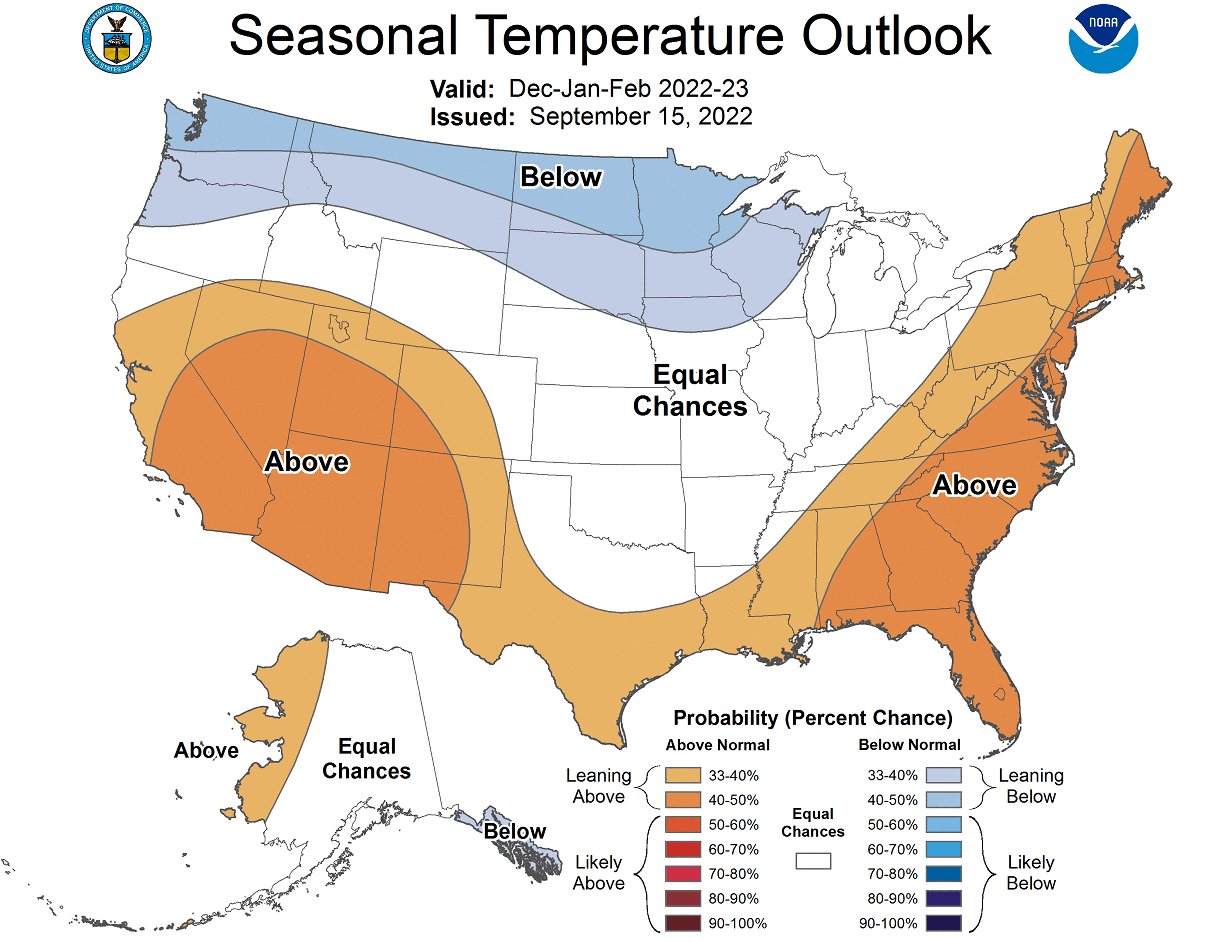
But take note of the trough of “equal” temperatures probability extending down low into the southern Plains. That can be interpreted as a potential route of winter cold air outbreaks down from the Midwest.
The official precipitation forecast is also quite similar to the updated models. We see an equal-to-higher probability for more precipitation (and snowfall) over the northern half of the United States. The southern United States is forecast to have a drier than normal winter season.

In a typical La Nina winter, there is usually a problem with the persistence of drought conditions in the south and southwest. Below is the latest drought graphic from NOAA, which shows the current drought conditions in the United States.

Strong drought conditions prevail over the south-central and western United States. We can see some recovery over the southwest, especially in Arizona. That is thanks to the summer monsoon bringing a decent amount of precipitation.
But the drought conditions in the south are expected to continue and can worsen in a La Nina Winter. The same goes for western parts of the United States, especially California.
There is no certainty in the winter forecast at this long lead time. But there is also one very important factor that can change the course of Winter at any time. That is the Stratospheric Polar Vortex.
STRATOSPHERIC POLAR VORTEX INFLUENCE
We cannot look at the winter weather without mentioning the Polar Vortex. The Polar Vortex re-emerges every Fall and plays a key role in daily to weekly weather development in late Fall, Winter, and Spring.
The Polar Vortex is a large cyclonic area spinning over the entire Northern Hemisphere, from the ground up to the top of the Stratosphere, reaching over 50km/31miles altitude.
Below is our 3-dimensional model of the Polar Vortex, extending from the lower levels upwards into the Stratosphere. The vertical axis is greatly enhanced for better visual purposes. You can see in the image below what the actual structure of the Polar Vortex looks like.

In the example above, the Polar Vortex underwent a temporary warming event. These events can disrupt the Polar Vortex, weakening its circulation and changing the weather patterns below.
That is very important for winter weather patterns, as it can change the dynamics and circulation for several weeks. But even a strong Polar Vortex plays a role.
A strong Polar Vortex usually means strong polar circulation. This usually locks the colder air into the Polar regions, resulting in milder seasonal conditions for most of the United States and Europe.
In contrast, a weak Polar Vortex can create a disrupted jet stream pattern. As a result, it has a harder time containing the cold air, which has an easier way of escaping from the polar regions into the United States or Europe.
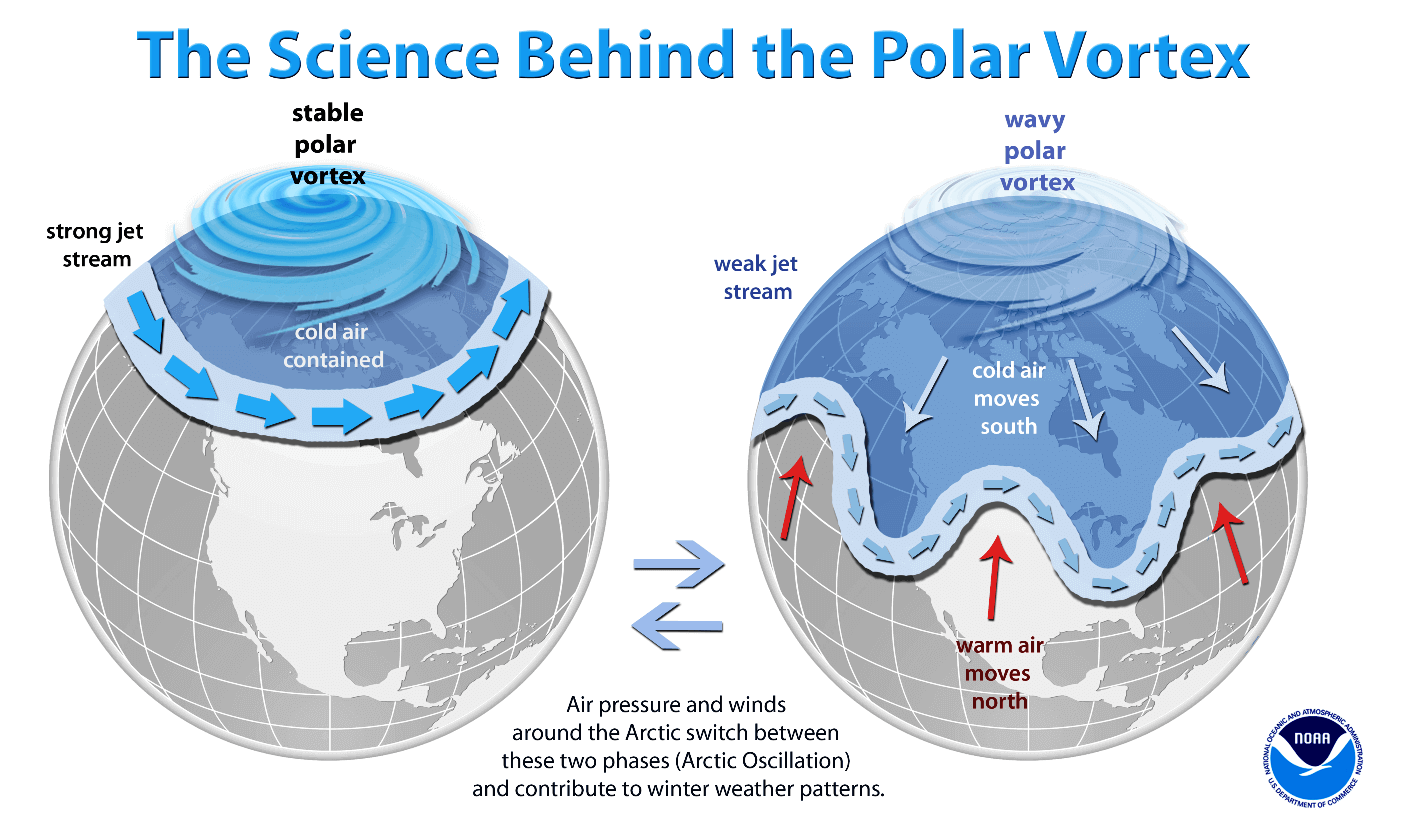
Historically, a La Nina winter has around a 60-75% chance of producing a stratospheric warming event. It has produced them in the past and also one the last Winter. The image below shows the typical Sudden Stratospheric Warming event frequency by month and by the ENSO event.

A Sudden Stratospheric Warming event (SSW) can significantly impact circulation and cause major pressure changes in the Northern Hemisphere. So we monitor these processes very closely.
One such event occurred on January 2021. On January 5th, the preliminary date of the Sudden Stratospheric Warming event was marked, as the winds around the polar circle have reversed.
The stratospheric warming wave has crawled over the entire North Pole in the Stratosphere, effectively splitting the cold core of the polar vortex into two parts.

One part of the broken polar vortex has moved over North America and one over the European sector. At this point, this did not influence the winter weather on the surface just yet. This is because such events begin at over 30km (18 miles) altitude. But the weather influence followed quite soon after.
In early January, strong positive values in the Stratosphere are associated with the higher pressure buildup during the stratospheric warming event. The event and its influence slowly descended over time, reaching the lower levels by mid and late January.
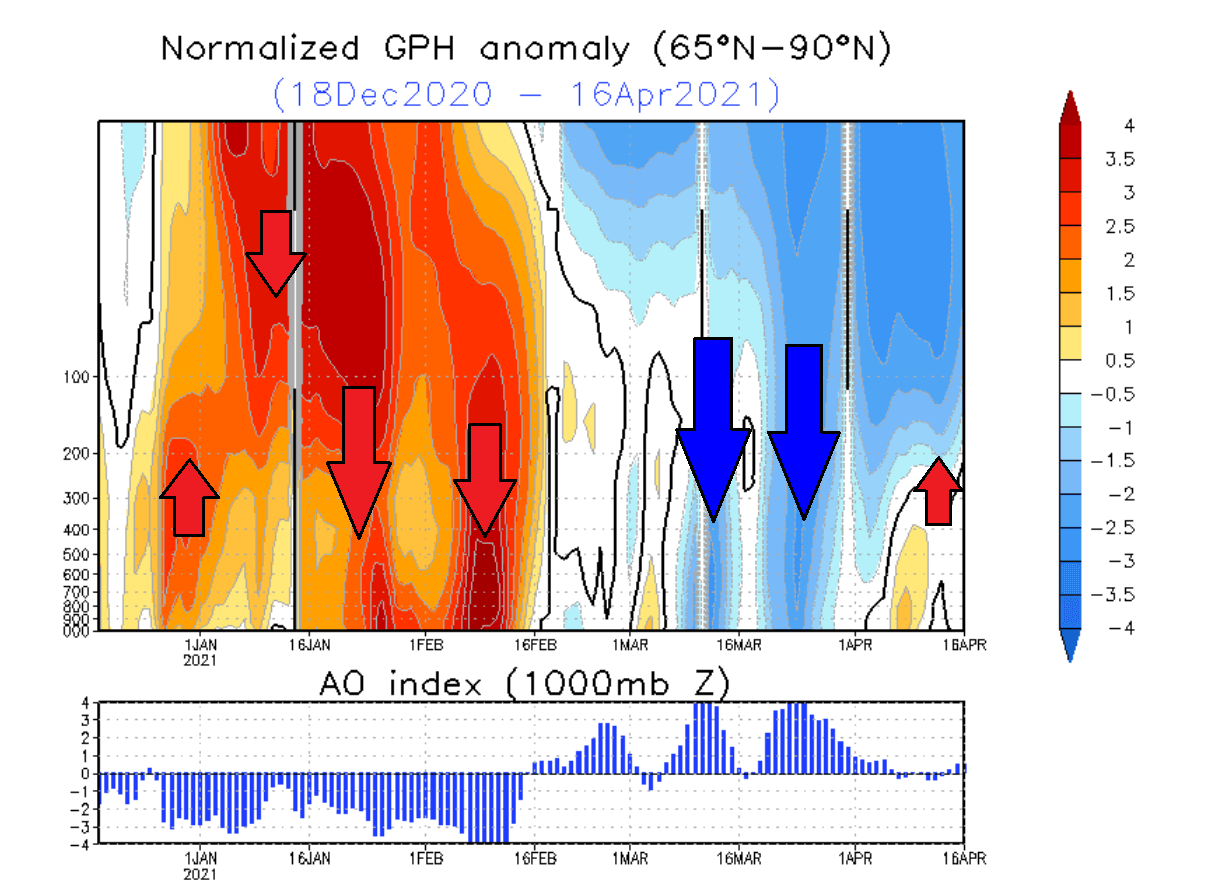
This persisted well into February, influencing the weather patterns even when the stratospheric warming was already over. You can see gradual progress downwards, almost like a wave. So despite starting at high altitudes, these warming events can bring strong dynamics down from the Stratosphere.
This is how a stratospheric warming event typically operates. First, it breaks down the upper structure of the Polar Vortex, which then collapses downwards, impacting the weather at the surface.
Below is an image that shows an average temperature pattern 0-30 days after a proper mid-winter stratospheric warming event. High pressure over the Arctic helps to unlock the cold air out of the Arctic regions, sending it down into the mid-latitudes of the United States and Europe.

Of course, not every stratospheric warming event produces this pattern, but this is an average image of many events in the past 40 years. A lot depends on the already established weather patterns and the timing of the stratospheric warming event.
There is not much forecast data to look at in the forecast for the Stratosphere. The ECMWF forecast for the 10mb stratospheric zonal winds shows a reduction of the stratospheric wind speeds in late Fall and early Winter.

As winds are directly related to the strength of the Polar Vortex, we can see this as a signal for a weakening of the Polar Vortex. This is likely connected to the suggested negative NAO pattern in late Fall and early Winter, so the model is picking up some dynamics.
It gives us a signal to keep an eye on, as these dynamics can have a large-scale and long-lasting impact on the weather pattern during Winter.
We will keep you updated on the developing weather trends in the coming seasons, so make sure to bookmark our page. Also, if you have seen this article in the Google App (Discover) feed, click the like button (♥) there to see more of our forecasts and our latest articles on weather and nature in general.
Don’t miss:
See also: